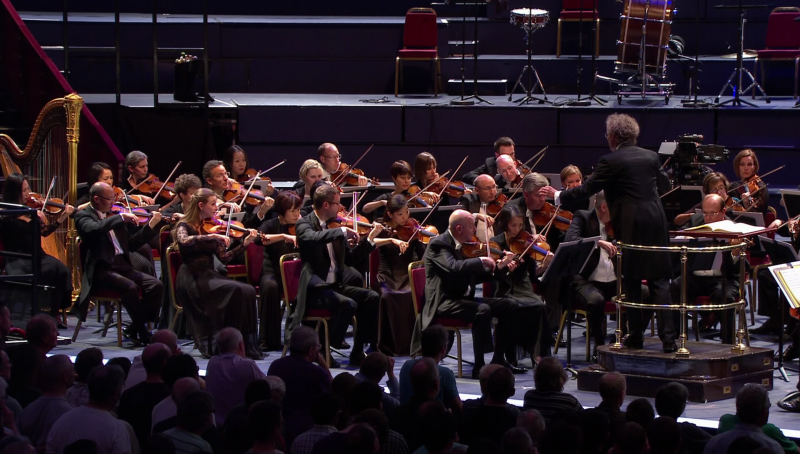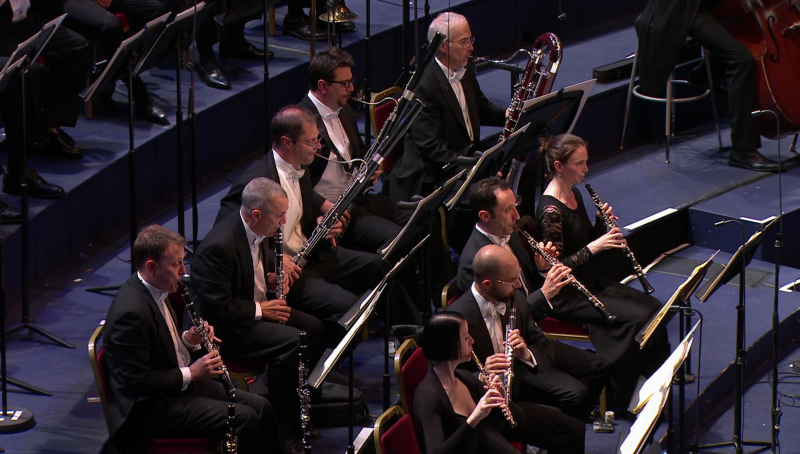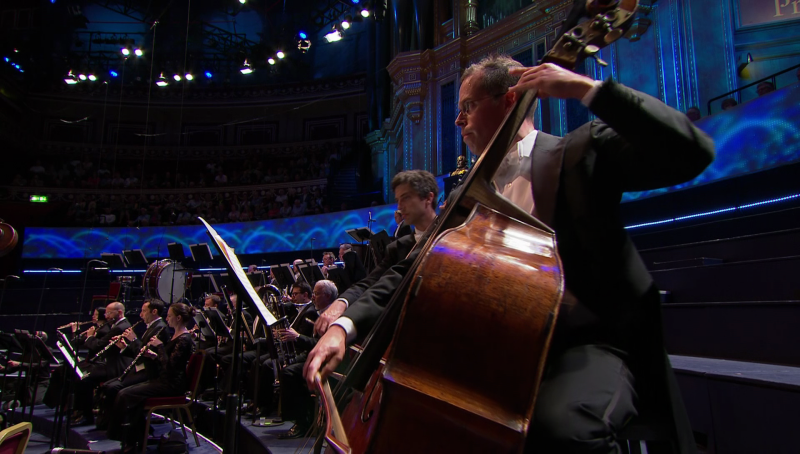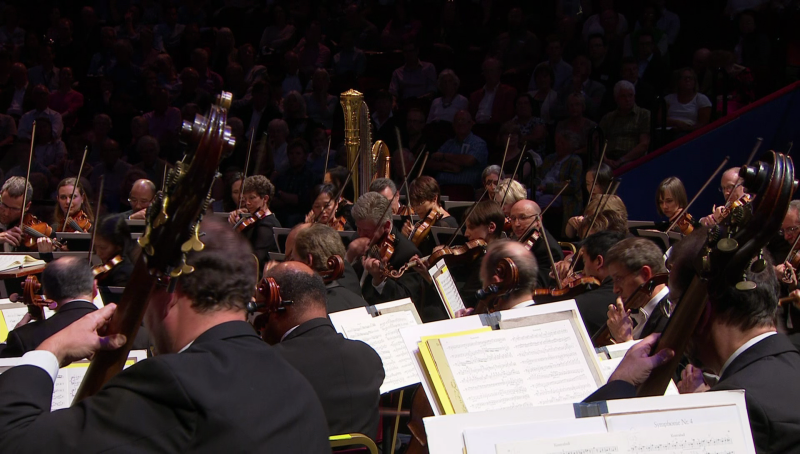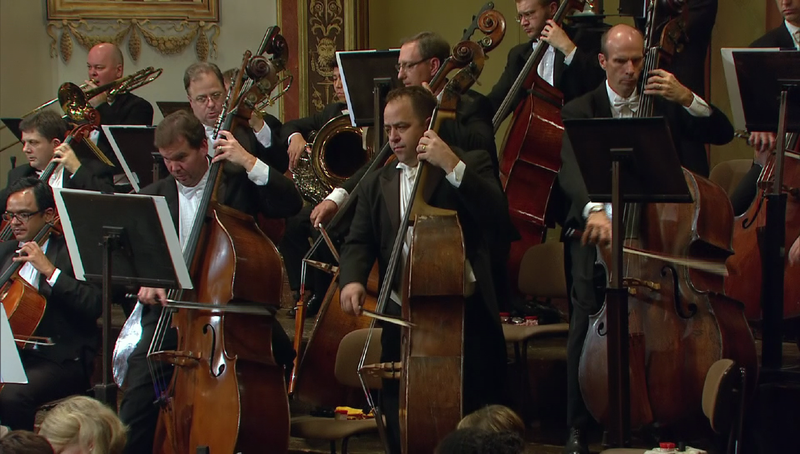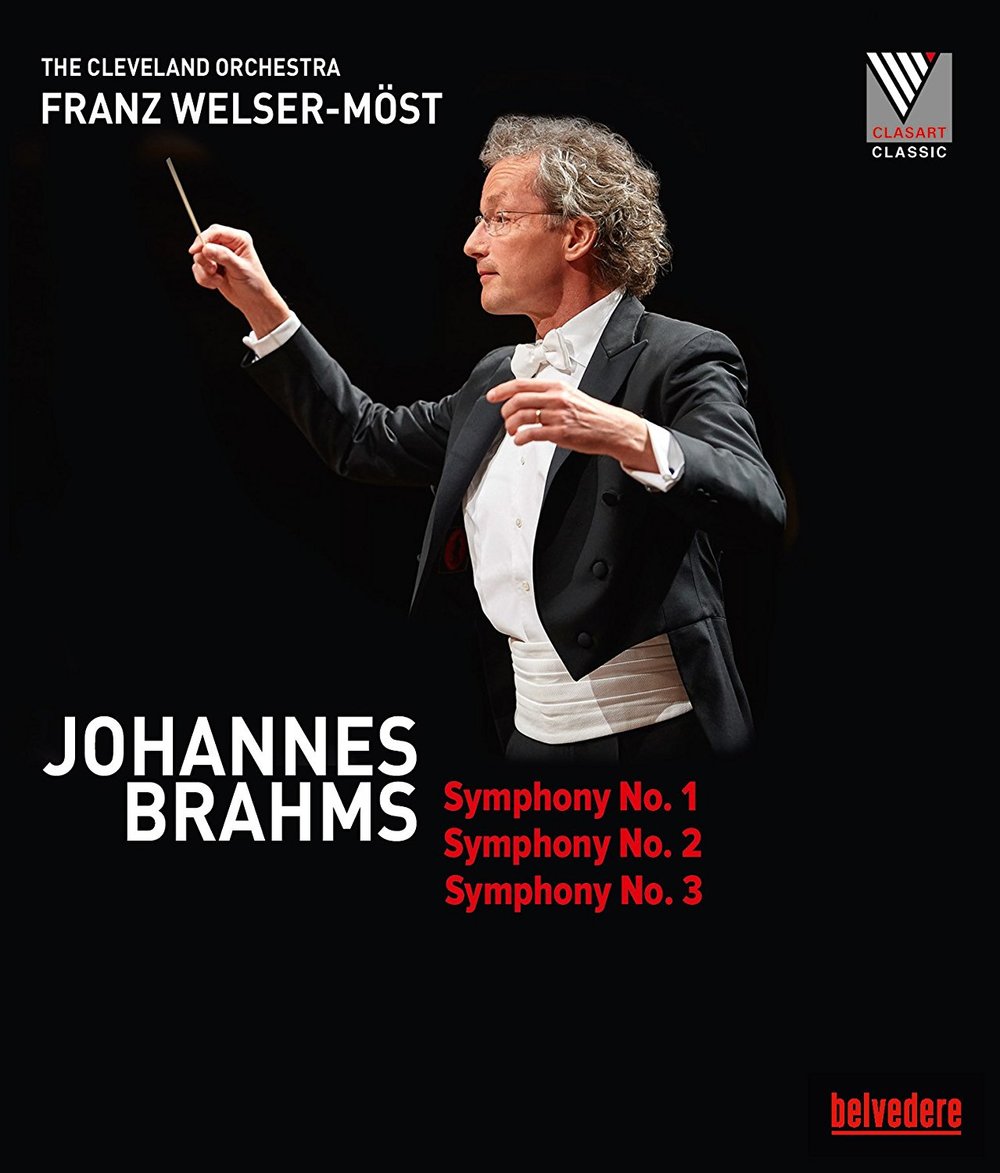
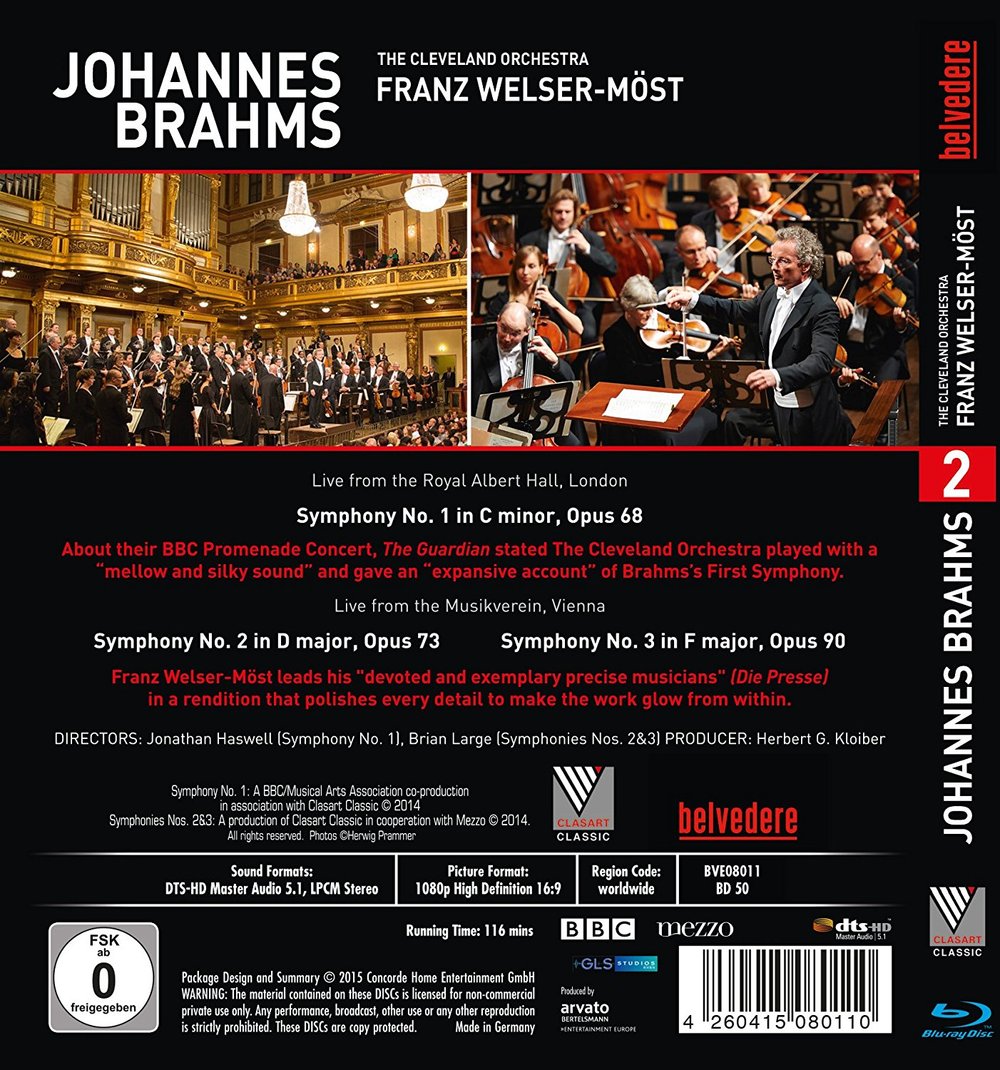
Brahms Symphonies 1-3. In 2014, Franz Welser-Möst conducts the Cleveland Orchestra in Symphony No. 1 at the Royal Albert Hall, London and Symphonies 2 and 3 at the Musikverein Golden Hall, Vienna. This disc is also available as part of a box set with Brahms' most famous symphonic works. Symphony 1 directed for TV Director by Jonathan Haswell; Symphonies 2 and 3 directed for TV by Brian Large. Herbert G. Kloiber was Producer. Released 2018, disc has 5.1 dts-HD Master Audio sound. Grade: For Symphony No. 1 B- For Symphonies 2 and 3: B
Symphony No. 1 at the Proms
Richard Osborne, writing in the January 2016 Gramophone at page 29, approved of the Welser-Möst interpretation of Brahms S1 and the sound recording, which he deemed better than all the other audio recordings made in Cleveland or Vienna and included in the Belvedere Brahms Cycle Box. We will accept Osborne's opinions on this as coming from on high.
Our humble comments will focus on the video. First we note that Severance Hall in Cleveland and the Golden Hall in Vienna are among the most beautiful music venues on earth. Alas, the bulbous Royal Albert Hall in London is one of the ugliest. Moving a big orchestra in, setting up, and escaping the RAH in the middle of the annual Proms marathon must be among the most challenging logistical tasks undertaken since the D-Day invasion of Normandy. This probably explains why many of the images shown below make me think of a battlefield.
There isn't a good whole-orchestra (WO) orientation shot for this Brahms S1. The two weaker WO shots shown first below combine to let the home audience viewer see where the various sections are seated:
Now we have the violin sections:
And below is a good shot of the double-bass section:
All the woodwinds:
A rare section of 5 horns. The score calls for 4 horns, but modern horn sections divide up responsibilities in creative ways:
You can see above that this video has some good long-range views of the kind we cherish. But the remaining screenshots below are representative of the many poor shots that plague this recording. The two double-bass players are easy to shoot from a camera on stage-right, and so we get the odd shot next below quite often:
And the low angle of the next shot ruins our view of the trombones and trumpets:
And what's the purpose of the next shot below:
And are any of these next 3 shots of the second violins worth keeping in the film?
And here's a strange instrument-only shot (of the concertmaster):
We did a Wonk Worksheet for this Brahms Symphony No. 1:
There are 39 minutes, 50 seconds of music divided into 395 video clips. This yields the (way too rapid) pace of 6.1 seconds per clip.
Here's the clip breakdown:
Conductor shots = 72
Conductor-over-backs shots = 22
Solo and other small-scale clips = 195
*Large-scale clips = 61
*Part-orchestra clips = 11
*Whole-orchestra clips = 18
Instrument-only clips = 4
Other low-value shots = 12
There are 90 "supershots" (add up the * numbers above of 61+11+18). So the supershots are 23% of the total clips (90/395). Conductor shots total 94 (72+22), and conductor shots use up 24% of the clips (94/395).
HDVDarts.com has established the following rules-of-thumb to identify a Blu-ray with DVDitis:
“A good symphony HDVD should have a slow pace with more than 10 seconds per video clip on average. 20 to 40% of the clips should be large-scale "supershots." Conductor shots should be less (way less really) than 20% of the clips in the video.”
Subject title badly fails the pace test (with the average clip running only 6.1 seconds, just a bit over half the minimum time for passing) and the conductor test at 24%. But thanks to a large number of whole and multiple section shots, it does pass the supershot test. So we must diagnose a moderate case of DVDitis.
Now for a grade. We start with A+. We reduce the grade to A for lack of 96kHz/24-bit sound. PQ is acceptable even if resolution is not as sharp as we would like. This title flunks 2 of the video content tests. So we reduce the grade from A to C. But that grade is too low. For a good performance and outstanding SQ (for the 48kHz/24-bit sound specs) we boost the grade up to B. But then we knock the grade back a notch for so many bad framing shots to a B-.
Symphonies Nos. 2 & 3 at the Musikverein
Richard Osborne, in his Gramophone story cited above, declares that Symphonies 2 & 3 are inferior in sound to Symphony 1. He calls the Symphony No. 2 performance "lyrical and ...surprisingly fiery"; but he pans Symphony No. 3 as "sadly under-powered" with a "prissily disengaged ... beat." We agree that the sound in the two Musikverien recordings are a bit muddier than it should be. But we will mostly focus on the video content. Brian Large directed both recordings in much the same style. We ran Wonk Worksheets on both, which we will discuss in detail later. But for our screenshots, we will let Symphony No. 2 stand in for both.
We start with a fair establishing shot of the center of the orchestra. Right away you can see the difficulty in shooting in this hall — the stage, narrow and shallow, was designed for an earlier era when concert orchestras were much smaller than today:
Large has filmed at the Musikverein many times. He does his best with the cramped space and gets a good number of large-group shots and partial-orchestra shots. Below we see most of the violins:
From the other side we see the cellos:
Next we have a valiant effort to get all the double basses:
Below is a multi-section shot --- percussion and horns:
Here we have all the woodwinds:
However there are still problematic shots. Below we see a conductor-over-backs shot that is mostly backs and sheet music:
Another sheet-music shot:
Perhaps the biggest issue with the video content is the over-reliance on solo shots of the woodwinds. They are directly in the middle of the stage, and therefore have the best angles for the camera. This leads to far too many shots like the following two:
These are nice shots, but they quickly grow tiresome when repeated too much.
Here are the Wonk Worksheets for Symphony No. 2 and Symphony No. 3.
For Symphony No. 2, there are 37 minutes, 10 seconds of music divided into 186 video clips. This yields a slow pace of 11.9 clips per second. This is a good pace, but we also note that very long conductor shots padded this score to some degree:
Here's the clip breakdown:
Conductor shots = 27
Conductor-over-backs shots = 23
Solo and other small-scale clips = 90
*Large-scale clips = 43
*Part-orchestra clips = 17
*Whole-orchestra clips = 14
Instrument-only clips = 12
Other low-value shots = 3
There are 74 "supershots" (add up the * numbers above of (43+17+14). So the supershots are 39% of the total clips (74/186). Conductor shots total 50 (27+23), and conductor shots use up 26% of the clips (50/186).
For Symphony No. 3, there are 30 minutes, 49 seconds of music divided into 184 video clips. This leads to a pace of exactly 10 clips per second with perhaps some padding from overly long conductor shots.
This is the clip breakdown:
Conductor shots = 23
Conductor-over-backs shots = 19
Solo and other small-scale clips = 66
*Large-scale clips = 52
*Part-orchestra clips = 10
*Whole-orchestra clips = 9
Instrument-only clips = 4
Other low-value shots = 1
There are 71 "supershots" (add up the * numbers above of (52+10+9). So the supershots are 39% of the total clips (71/184). Conductor shots total 42 (23+19), and conductor shots use up 22% of the clips (42/184).
HDVDarts.com has established the following rules-of-thumb to identify a Blu-ray with DVDitis:
“A good symphony HDVD should have a slow pace with more than 10 seconds per video clip on average. 20 to 40% of the clips should be large-scale "supershots." Conductor shots should be less (way less really) than 20% of the clips in the video.”
Both symphonies pass the pace test, with the caveat (especially in Symphony No. 2) that some of the slow pace is attributed to overly long shots of the conductor. Stated differently, while titles pass the pace test, the slow pace isn't always spent wisely. Both titles confidently pass the supershot test with 39%, and both fail the conductor test with 26% and 22% respectively. So for these recordings we diagnose mild DVDitis.
We will grade Symphonies 2 and 3 the same. We start with A+ which is reduced to A for lack of 96kHz/24-bit sound. Both titles flunk the conductor test. So we reduce the grade from A to B. We reduce the grade further for overly-long conductor shots and too many shots of the principal flute and oboe. But we will offset this with a boost for healthy supershot numbers and nice PQ in this exceptionally beautiful venue. So we wind up with a B, which is a pretty good grade in this era of raging cases of symphony DVDitis.
OR


